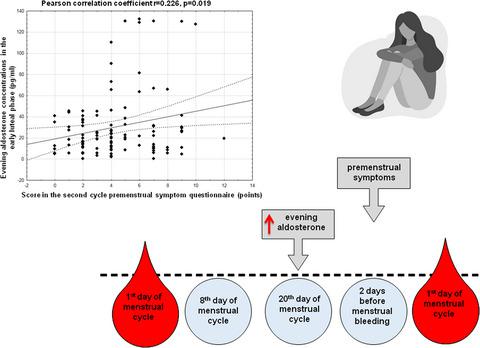当前位置:
X-MOL 学术
›
J. Neuroendocrinol.
›
论文详情
Our official English website, www.x-mol.net, welcomes your
feedback! (Note: you will need to create a separate account there.)
Steroid stress hormone changes throughout the menstrual cycle: A rise in evening aldosterone concentration in early luteal phase precedes the symptoms of premenstrual syndrome
Journal of Neuroendocrinology ( IF 3.3 ) Pub Date : 2021-09-16 , DOI: 10.1111/jne.13043 Lubomira Izakova 1 , Natasa Hlavacova 2 , Daniela Jezova 2
Journal of Neuroendocrinology ( IF 3.3 ) Pub Date : 2021-09-16 , DOI: 10.1111/jne.13043 Lubomira Izakova 1 , Natasa Hlavacova 2 , Daniela Jezova 2
Affiliation

|
There is still a lack of consistent evidence on dysregulation of steroid stress hormones cortisol and aldosterone in premenstrual syndrome (PMS). We aimed to test the hypothesis that, in healthy women, salivary aldosterone concentrations are higher in those with PMS compared to controls, particularly during the luteal phase of the menstrual cycle. In total, 99 female subjects (49 women with and 50 women without PMS) participated in a prospective non-interventional case–control study. Saliva sampling was performed in the follicular (day 8), early luteal (day 20) and late luteal phase (2 days before expected onset of bleeding) of the menstrual cycle in the morning and the evening. The results confirmed the hypothesis that salivary aldosterone concentrations are higher in women with PMS during the early luteal phase compared to controls (p < .01) in the evening. Early luteal phase aldosterone concentrations positively correlated with the frequency of premenstrual symptoms. Women with PMS exhibited a flatter morning to evening aldosterone slope compared to controls (p < .05). Morning and evening salivary cortisol concentrations were unchanged throughout the menstrual cycle in both groups of women. In conclusion, evening salivary aldosterone, but not cortisol concentrations, are increased in women with PMS during the early luteal phase compared to controls. Cortisol does not appear to be involved in the mechanisms contributing to the course of PMS. High evening salivary aldosterone in the early luteal phase may represent an important risk factor and could be of predictive value for the occurrence of premenstrual symptoms.
中文翻译:

类固醇应激激素在整个月经周期中发生变化:黄体早期晚上醛固酮浓度升高先于经前综合症症状
关于经前综合症 (PMS) 中类固醇应激激素皮质醇和醛固酮的失调仍缺乏一致的证据。我们的目的是检验以下假设:在健康女性中,经前综合症患者的唾液醛固酮浓度高于对照组,特别是在月经周期的黄体期。总共有 99 名女性受试者(49 名患有经前综合症的女性和 50 名没有经前综合症的女性)参加了一项前瞻性非干预性病例对照研究。在月经周期的卵泡期(第8天)、黄体早期(第20天)和黄体后期(预计出血前2天)的早晨和晚上进行唾液取样。结果证实了这样的假设:与对照组相比,患有经前综合症的女性在黄体期早期的唾液醛固酮浓度较高 ( p < .01)。黄体早期醛固酮浓度与经前症状的频率呈正相关。与对照组相比,患有经前综合症的女性从早到晚表现出更平坦的醛固酮斜率 ( p < .05)。两组女性在整个月经周期中早上和晚上的唾液皮质醇浓度都没有变化。总之,与对照组相比,患有经前综合症的女性在黄体期早期,晚间唾液醛固酮浓度升高,但皮质醇浓度升高。皮质醇似乎并不参与导致经前综合症进程的机制。黄体期早期晚上唾液醛固酮升高可能是一个重要的危险因素,并且对经前症状的发生具有预测价值。
更新日期:2021-10-15
中文翻译:

类固醇应激激素在整个月经周期中发生变化:黄体早期晚上醛固酮浓度升高先于经前综合症症状
关于经前综合症 (PMS) 中类固醇应激激素皮质醇和醛固酮的失调仍缺乏一致的证据。我们的目的是检验以下假设:在健康女性中,经前综合症患者的唾液醛固酮浓度高于对照组,特别是在月经周期的黄体期。总共有 99 名女性受试者(49 名患有经前综合症的女性和 50 名没有经前综合症的女性)参加了一项前瞻性非干预性病例对照研究。在月经周期的卵泡期(第8天)、黄体早期(第20天)和黄体后期(预计出血前2天)的早晨和晚上进行唾液取样。结果证实了这样的假设:与对照组相比,患有经前综合症的女性在黄体期早期的唾液醛固酮浓度较高 ( p < .01)。黄体早期醛固酮浓度与经前症状的频率呈正相关。与对照组相比,患有经前综合症的女性从早到晚表现出更平坦的醛固酮斜率 ( p < .05)。两组女性在整个月经周期中早上和晚上的唾液皮质醇浓度都没有变化。总之,与对照组相比,患有经前综合症的女性在黄体期早期,晚间唾液醛固酮浓度升高,但皮质醇浓度升高。皮质醇似乎并不参与导致经前综合症进程的机制。黄体期早期晚上唾液醛固酮升高可能是一个重要的危险因素,并且对经前症状的发生具有预测价值。











































 京公网安备 11010802027423号
京公网安备 11010802027423号